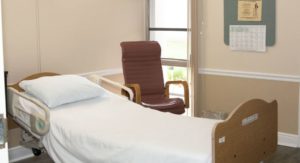Statistics Involving Falls in Senior Living Facilities
Getting older comes with its fair share of mobility problems, and many people assume that falling down is one of them. However, falls are not a guaranteed part of growing old, especially in nursing homes and assisted living centers. In fact, such facilities have a responsibility to prevent falls and encourage residents to be safe when moving about. Despite this, more than three million people—the majority being elderly—are taken to emergency rooms each year for fall injuries.
In fact, falls are some of the most common reasons that elderly individuals visit the hospital, and more than 800,000 of those patients stay for at least a day for treatment. To prevent more fall injuries from occurring and protect some of the most vulnerable members of the population, nursing homes and private care facilities alike must ensure that they implement robust fall prevention strategies—and families must remain vigilant for signs that facilities are not doing their jobs.
Was your loved one injured from a fall in a nursing home, assisted living, or memory care facility? Our elderly fall attorneys specialize in these kinds of cases. Call us now, toll-free, for a free case consultation: 888-375-9998.
The Statistics on Falls in the Elderly Population
 As mentioned previously, nearly a million people are hospitalized each year for injuries resulting from falls. Of course, not all of these are injuries sustained by elderly victims of senior living negligence, but this segment of the total fall injury population is higher than ever before. Hip fractures (alongside head injuries) are the leading causes of admission into a hospital. A total of 95% of all hip fractures result from a fall, and up to half of all elderly people (age 65 and up) who suffer a fracture in the hip pass away in the following 12 months after the break. Those who do not rarely regain the full quality of life that they had before the injury.
As mentioned previously, nearly a million people are hospitalized each year for injuries resulting from falls. Of course, not all of these are injuries sustained by elderly victims of senior living negligence, but this segment of the total fall injury population is higher than ever before. Hip fractures (alongside head injuries) are the leading causes of admission into a hospital. A total of 95% of all hip fractures result from a fall, and up to half of all elderly people (age 65 and up) who suffer a fracture in the hip pass away in the following 12 months after the break. Those who do not rarely regain the full quality of life that they had before the injury.
Additionally, falls are the most common cause of traumatic brain injury (such as brain bleeds), and of those who go to the hospital for injuries to the brain, 31.4% are over the age of 75. Between hip fractures and head injuries, the elderly population is at significant risk of severe damage or even death from falls. And perhaps even more concerning—the rate at which older individuals are falling (and dying from their injuries) has only continued to increase. The period between 2009 and 2018 saw a 30% spike in deaths resulting from falls in older adults.
Increasing Costs Shouldered by Federal Programs
In line with the steady increase of falls and related deaths in long-term care facilities, Medicare and Medicaid programs have seen surging expenditures to cover the costs. Of the $50 billion in medical costs spent just on falls in 2015, $750 million was dedicated to falls that resulted in the death of the resident. Families were left paying some medical bills; on average, Medicare and Medicaid paid about 75% of the costs of treatment for falls.
The programs must carve out a significant portion of their yearly expenses directly dedicated to falls. For Medicare, this is about $30 billion (or around 6% of their overall spending), and about $9 billion (or 8%) for Medicaid. Advocates for improved wellness in nursing homes—and for the elder population in general—are encouraging both private homes and nursing home facilities to improve their fall prevention practices. Not only will this improve the quality of life and safety for millions of at-risk adults, but it could also significantly reduce the costs of services provided by Medicaid.
The CDC’s STEADI Program

Falls are not “just a part of life” when you get old, and there is no “right to fall” in a nursing home or ALF. Experts across the country have developed numerous evidence-based strategies for cutting down on the risk of falls and their resulting injuries. These programs vary in both their efficacy and means of application, with some focusing on tackling mobility issues or the layout of a space and others keying in on how individual people (like the resident, caregivers, doctors, and more) approach the challenge of getting an elderly loved one from point A to point B.
The most common fall prevention measures primarily focus on the 30% to 50% of falls that are directly related to environmental conditions. These could be, for example, bunched up carpet, dim lighting, trip hazards, or slippery surfaces. The Centers for Disease Control has been taking a proactive approach to fall prevention by establishing STEADI, the Stopping Elderly Accidents, Deaths, and Injuries tool kit, for nursing homes. This program incorporates the clinical guidelines for preventing falls that have been established by the American Geriatrics Society.
One of the main draws for nursing homes implementing the STEADI program is the promise of potential incentives. Facilities that practice STEADI may receive advantages for improving not only their active fall prevention strategies but also their risk assessments when new residents are completing their intake. Additionally, STEADI encourages continuing education to help providers stay up to date with the current knowledge on fall prevention and risk assessment. This type of education is critical, because as facilities have learned in the past, “best practices” can change—such as when bed rails began to fall out of favor due to the high incidence of resident suffocation and injury.
However, nursing homes are not required to adopt the STEADI program, and other sources indicate that facilities often attempt the bare minimum possible to achieve an acceptable rating. Part of improving the quality of care for elderly individuals will require more robust—and mandatory—improvements in fall prevention. Some of these may include greater accessibility to private, in-home modifications so that elderly individuals may “age in place” when possible.
Fall Reduction at Home Can Reduce Nursing Home Transfer
Studies indicate that older individuals enjoy a higher quality of life when they are supported to “age in place,” or stay in their own residence for as long as possible. Many nursing home residents are only admitted to the facility because they need additional support that their own home cannot provide. This burden on facilities—which are already understaffed, contributing to further cost-cutting measures such as inadequate fall prevention—could be mitigated by supporting families in keeping their older loved ones at homes safely.
The National Council on Aging recognizes that falls are the number one leading cause of death and injury for people over 65 years of age, and their Falls Free National Action Plan includes provisions for keeping older individuals safe both at home and in nursing homes. Home modifications are an important part of this process.
Unfortunately, most elderly individuals and their families do not have the financial means to install many of the necessary tools to stay safe from falls. Healthcare costs generally rise with age, and nearly 40% of adults over the age of 62 have less than $25,000 in free assets available to fund medical safety equipment. Some modifications, such as removing loose rugs or changing lightbulbs out for brighter options, are accessible to most families. However, more involved installations such as shower bars or home modifications allowing for a wheelchair can be out of reach for many, prompting the move to nursing homes that are similarly unequipped for long-term fall prevention.
Medicare and Medicaid may be able to pay for some modifications, but states are increasingly contributing too. Colorado, for example, will contribute up to a lifetime amount of $14,000 for the purpose of modifying a home to improve quality of life. This might include, among other things, wheelchair ramps and widening doorways.
States Are Taking Action
In the face of increasing fall statistics over recent years—and no sign of a change in that trend—states are adopting legislation to safeguard their vulnerable elderly population. California has established SB 280, which allows the Department of Housing to more seamlessly include accessibility options like grab bars in construction or to make amendments to buildings to include them. Washington, New York, Connecticut, and New Mexico are all increasing advocacy in their states and supplying elderly individuals with resources to learn more about how to reduce their risk of falls. Multiple states, including Minnesota, have begun to require care givers to complete training specifically geared toward preventing falls.
The results of these and other initiatives have indicated that the most effective programs are those that cover a wide range of areas: education, direct applications, and availability of resources all at once. More states are being encouraged to adopt programs, but a nationwide effort is still far from complete. Even in facilities that have undergone the proper training or participate in programs like STEADI, falls resulting from abuse or negligence are still possible. Thus, it is vital that families remain vigilant about the care that their loved ones are receiving. Falls are not a guaranteed part of growing older, and your beloved family members deserve the best care possible—free from accidental falls.
Fall in a Facility? Speak with a Lawyer Now

A fall in a nursing home, assisted living, or memory care facility is not a normal outcome of a residency. Falls can, and should, be prevented through appropriate care and supervision.
Our nursing home fall attorneys specialize in these senior fall cases resulting in serious injury or wrongful death. Learn more about your rights under state and federal law. Call Senior Justice Law Firm today for a free case consultation: 888-375-9998.



